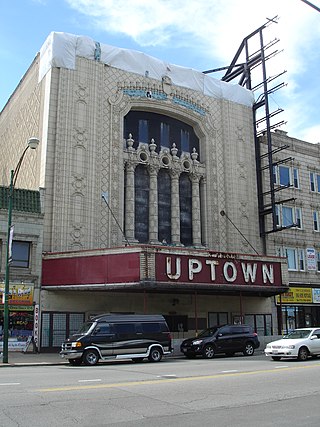
A movie palace is any of the large, elaborately decorated movie theaters built between the 1910s and the 1940s. The late 1920s saw the peak of the movie palace, with hundreds opening every year between 1925 and 1930. With the advent of television, movie attendance dropped, while the rising popularity of large multiplex chains in the 1980s and 1990s signaled the obsolescence of single-screen theaters. Many movie palaces were razed or converted into multiple-screen venues or performing arts centers, though some have undergone restoration and reopened to the public as historic buildings.
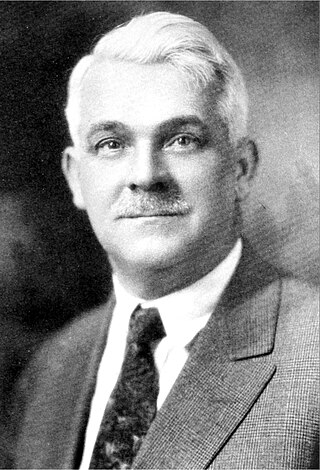
Thomas White Lamb was a Scottish-born, American architect. He was one of the foremost designers of theaters and cinemas of the 20th century.
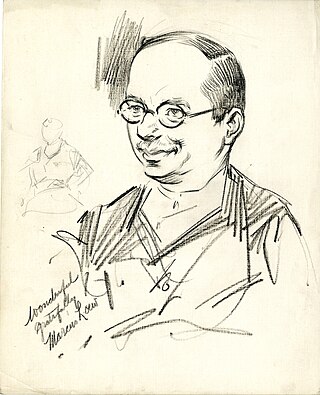
Marcus Loew was an American business magnate and a pioneer of the motion picture industry who formed Loew's Theatres and the Metro-Goldwyn-Mayer film studio (MGM).

Shea's Performing Arts Center is a theater for touring Broadway musicals and special events in Buffalo, New York. Originally called Shea's Buffalo, it was opened in 1926 to show silent movies. It took one year to build the entire theatre. Shea's boasts one of the few theater organs in the US that is still in operation in the theater for which it was designed.
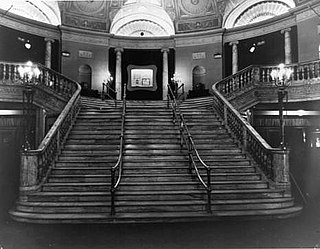
The Capitol Cinema was the largest movie theatre ever built in Ottawa, Ontario, Canada, and was the city's only true movie palace. Opened in 1920, the 2530-seat cinema was regarded as one of the best cinemas designed by famed theatre-architect Thomas W. Lamb.
The Cultural District is a fourteen-square-block area in Downtown Pittsburgh bordered by the Allegheny River on the north, Tenth Street on the east, Stanwix Street on the west, and Liberty Avenue on the south.

The Lafayette Theatre(1912–1951), known locally as "the House Beautiful", was one of the most famous theaters in Harlem. It was an entertainment venue located at 132nd Street and 7th Avenue in Harlem, New York. The structure was demolished in 2013.
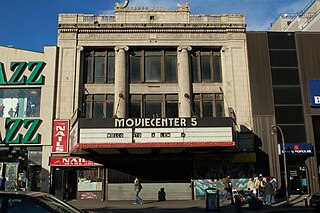
The Victoria Theater was a theater located on 125th Street in the Harlem neighborhood of Manhattan in New York City. It was designed in 1917 by Thomas W. Lamb, a notable and prolific theater architect of the era, for the Loew's Corporation. It was largely demolished in 2017, with the facade and lobby retained as part of a new mixed-use skyscraper, the tallest building in Manhattan north of Central Park.

An atmospheric theatre is a type of movie palace design which was popular in the late 1920s. Atmospheric theatres were designed and decorated to evoke the feeling of a particular time and place for patrons, through the use of projectors, architectural elements and ornamentation that evoked a sense of being outdoors. This was intended to make the patron a more active participant in the setting.

The Landmark Theatre, originally known as Loew's State Theater, is a historic theater from the era of movie palaces, located on South Salina Street in Syracuse, New York, United States. Designed by Thomas W. Lamb, it is the city's only surviving example of the opulent theatrical venues of the 1920s. The Landmark is on the National Register of Historic Places.

Palladium Times Square is an indoor live events venue in New York City, located in One Astor Plaza, at the corner of Broadway and 44th Street. It was designed by architect David Rockwell and opened in September 2005. The venue has a large standing room orchestra section, combined with a large area of seating towards the rear of the auditorium.
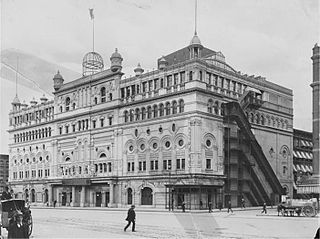
The Olympia Theatre, also known as Hammerstein's Olympia and later the Lyric Theatre and the New York Theatre, was a theatre complex built by impresario Oscar Hammerstein I in Longacre Square, New York City, opening in 1895.

State Palace Theatre is a performing arts venue located in downtown New Orleans, Louisiana. It is located at the uptown lake corner of Canal Street and Rampart Street. The Saenger Theater is directly opposite the State Palace on Canal Street.

Loew's Theatre is a historic movie theater located on Main Street in the Downtown section of the city of New Rochelle in Westchester County, New York.
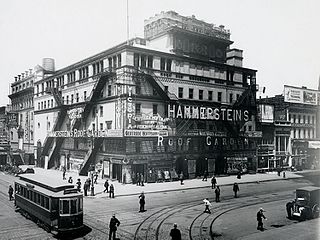
The Victoria Theatre was a prominent American vaudeville house during the early years of the twentieth century. Theatre mogul Oscar Hammerstein I opened it in 1899 on the northwest corner of Seventh Avenue and 42nd Street, along New York City's Longacre Square. The theatre was closely associated with the Paradise Roof Garden above it, and the two venues came to be known collectively as Hammerstein's. The Victoria closed in 1915.

The Loew's State Theatre was a movie theater at 1540 Broadway on Times Square in New York City. Designed by Thomas Lamb in the Adam style, it opened on August 29, 1921, as part of a 16-story office building for the Loew's Theatres company, with a seating capacity of 3,200 and featuring both vaudeville and films. It was the first theater on Broadway to cost $1 million. It was initially managed by Joseph Vogel, who later became president of Loew's Inc. and then MGM.
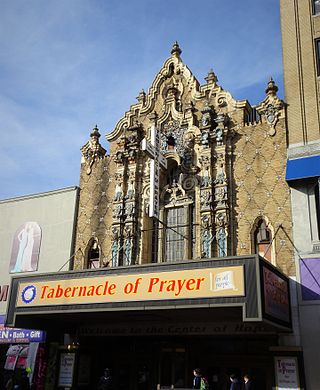
The Loew's Valencia Theatre is a former movie palace at 165-11 Jamaica Avenue in Queens, New York City. Built in 1929 as one of the Loew's Wonder Theatres, the theater was donated to The Tabernacle of Prayer for All People in 1977. It was designated an exterior landmark on May 25, 1999 by the New York City Landmarks Preservation Commission.

The Columbia Theatre, located at 1112 F Street NW, Washington, DC 20004, was a theater built and opened in 1891, closed and demolished in 1959. The Arnold & Porter Building is on the site today.
The Murray Hill Theatre was a Broadway theatre located on Lexington Avenue between East 41st and 42nd streets in Manhattan, New York City. It operated as a legitimate theatre for plays, musicals, and operas until it became a part of the Columbia Amusement Company's chain of burlesque theaters in 1908. The theatre was acquired by the motion picture empire of Marcus Loew, and re-opened as a movie theatre, Loew's 42nd Street Theatre, in 1917. It continued to operate as a movie theatre until it was demolished in 1951.
The Circle Theatre was a Broadway theatre, concert hall, movie theatre, and venue for vaudeville and burlesque located at the corner of Broadway and West 60th Street. It was the first theatre built in the Columbus Circle area of Manhattan. It's address was 1825 Broadway.


















